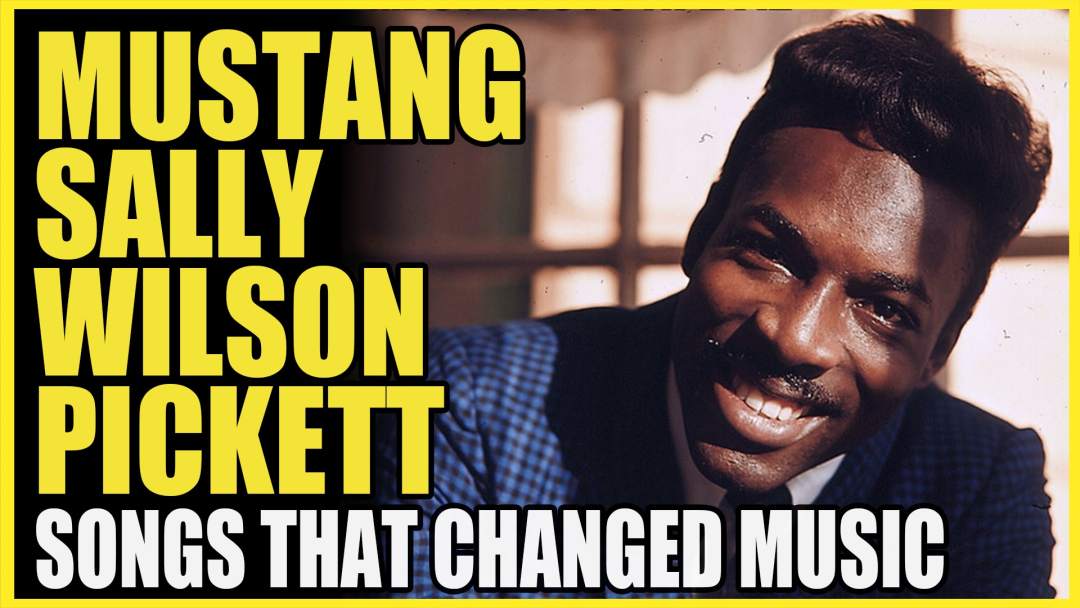Written by Caitlin Vaughn Carlos
In 1966, Wilson Pickett entered FAME studios in Muscle Shoals to record some of his most famous songs of all time, including the now legendary – “Mustang Sally.” Originally written by Pickett’s former Falcons bandmate, Sir Mack Rice, Pickett’s version, produced by Atlantic Records’ Jerry Wexler and FAME studios owner Rick Hall, took a great Rhythm and Blues hit to mainstream success, with the talents of the studio’s incredible house musicians.
Although “Mustang Sally” is most commonly associated with Wilson Pickett, the song was first written and recorded by Pickett’s former Falcons bandmate Sir Mack Rice. Rice was inspired to write the Rhythm and Blues song after visiting Della Reese and her drummer Calvin Shields. Reese had wanted to buy Shields a Lincoln as a birthday present, to which he responded that he would rather have a Ford Mustang. While driving around town, Rice admitted he had never heard of the Mustang, when Shields pointed out a poster of one. Rice was shocked at the size of the vehicle, declaring that, in Detroit, they only drove big cars: Cadillacs, Lincolns and Mercedes-Benzs. However, the image of the new Mustang stuck in his head, and inspired him to write about a woman who only wants to ride around in her car all day.
The lyrics on the song’s chorus were inspired by a nursery rhyme Rice had heard growing up:
Little Sally Walker/Sittin’ in a saucer
Weepin’ and a-cryin’/For a cool drink of water
Rise Sally rise/Wipe your weepin’ eyes
Rice was still working out the details when he played a version of the song for Aretha Franklin, in which he used the lines “Rise, Sally Rise”. Aretha suggested that Rice change the words from “Rise Sally Rise” to “Ride Sally Ride” Rice admitted being a little hesitant to the change, but when Aretha sat down at the piano to play along, he knew the song was on the right track. The final touch was also her influence – changing the name of the song from “Mustang Mama” to Mustang Sally”
Rice released his version in 1965 and it hit number 15 on the Rhythm and Blues charts. When Pickett heard Rice perform the song at the Apollo Theater, he decided to record his own version – and it was Pickett’s version that would bring the song to legendary status.
Pickett recorded his version at FAME studies in Muscle Shoals, Alabama in sessions that also produced his hit single “Land of 1000 Dances”. FAME, or Florence Alabama Music Enterprises was founded by Rick Hall, Billy Sherrill, and Tom Stafford in Florence, Alabama, in the late 50s. In 1960, Hall became the sole owner of FAME and moved his efforts to Muscle Shoals, Alabama, After the success of Arthur Alexander’s hit “You Better Move On,” he was able to use the funds to settle the studios in the now legendary location of 603 East Avalon Avenue.
FAME quickly earned a reputation for its incredible house musicians, including the rhythm section – often called “The Swampers,” The studio and these musicians attracted the attention of Jerry Wexler of Atlantic Records. Wexler, who housed Pickett under his label, sent Pickett to record there.
Wexler and FAME owner Rick Hall produced “Mustang Sally” and the song features the talents of a combination of Atlantic Records’ and FAME studio’s best musicians, such as memphis guitarist Chips Moman, and FAME studio guitarist Jimmy Johnson.
Roger Hawkins played drums and Tommy Cogbill performed on bass.
Dewey “Spooner” Oldham played keyboard on the track, thanks to his own ingenuity. He told Songfacts in a 2012 Interview: “I was sitting on a stool, and we listened to a demo of Sir Mack Rice who wrote the song, and the first thing I noticed was there was no keyboard on that record. But I’m here, I want the job – what am I going to do that will work within that song? And I just closed eyes for a second, daydreaming, and said, ‘I wonder what it would sound like if I pretended I was a Harley Davidson motorcycle and was driving through the studio, what would that sound like?’ There’s a little pause in that record where there’s not much going on, and I do rorp-rorp-rorp kind of revving engine thing. And Jerry Wexler liked it, because he later tried to get me to do it again when I was in New York. Of course, I didn’t, it was specific for that song.” The phenomenal work of all of these musicians was the perfect pairing with the incredible and soulful vocal talents of Wilson Pickett.
According to Oldham, recording “Mustang Sally” only took 3 or less takes, but almost ended in disaster. After a particularly great take, the group gathered in the control room with engineer Tom Dowd. Oldham recalled: “So Tom Dowd, I think, was sitting at the tape machine and was gonna play it. And when it started rewinding, the metal capstand that holds the tape in place just flew off – and little splinters of tape went flying across the room! So we just automatically bent over and started pickin’ up little pieces of tape, and Wilson Pickett is sort of cursing, “We ruined my master!” Dowd kept his cool, and sent the musicians out of the room for about 30 minutes, while he pieced together, 30-40 little bits of tape and saved the record!
Pickett’s version of “Mustang Sally” was released in 1966 and by January of 1967, it had peaked at No. 6 on the Billboard Rhythm and Blues Charts. Pickett’s version became the essential recording, which brought the song to incredible heights. Rolling Stone Magazine has repeatedly included it on its list of the 500 Greatest Songs of All Time, and the track remains one of the most iconic recordings of Pickett’s career. In 1991, Pickett was inducted into the Rock and Roll Hall of Fame.
Watch below – Songs That Changed Music: Wilson Pickett – Mustang Sally.
